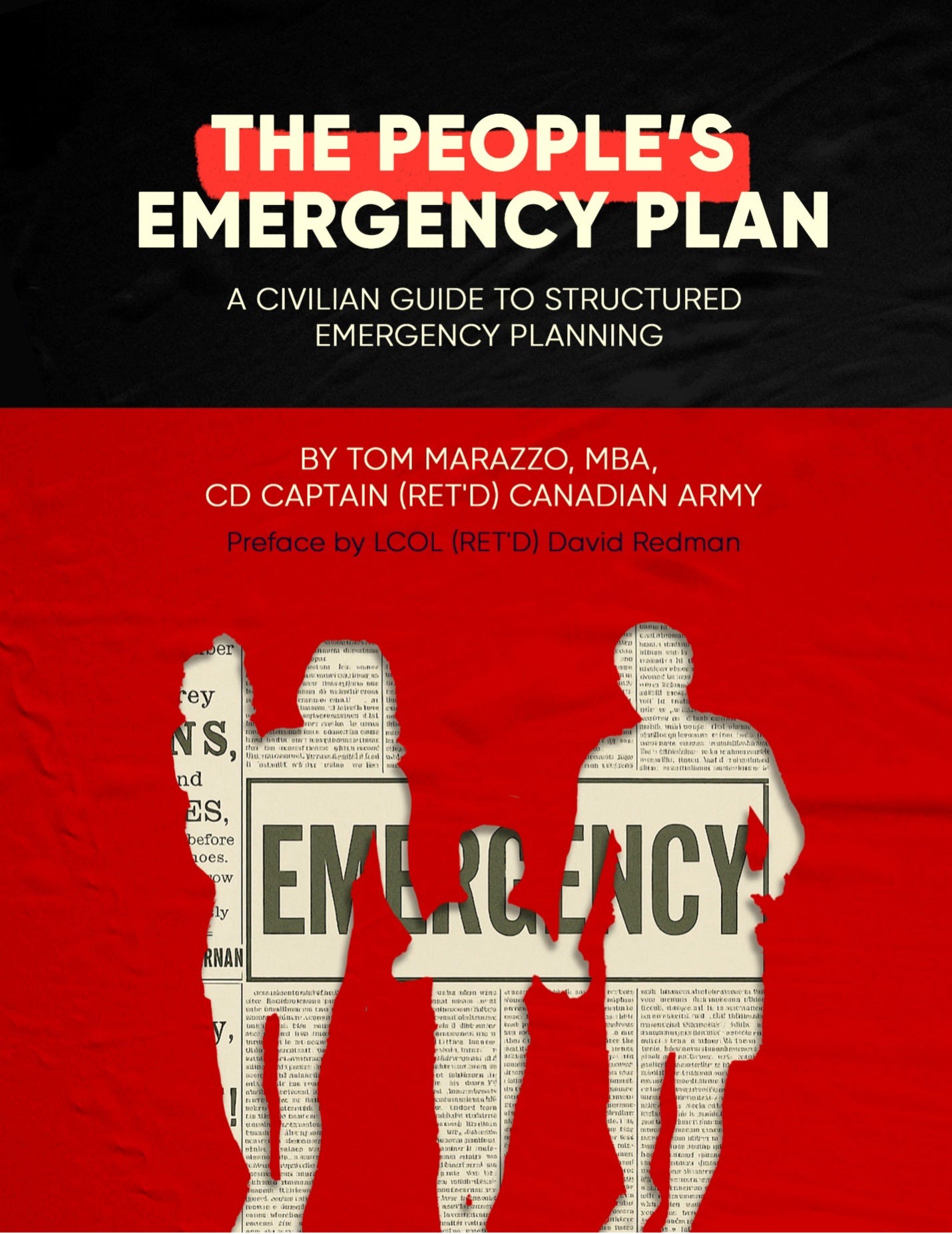The People’s Emergency Plan: A Civilian Guide to Operational Emergency Planning & Preparedness
Submitted by Tom Marazzo
Tom sent me his book and I’m so impressed with it that I asked him to submit an article to our Substack so y’all were aware of this really awesome resource.
Enjoy the article below the book cover!
Godspeed,
Chris Heaven, CEO
Survival Dispatch
I didn’t write this book to sell fear. I wrote it because I believe people need a real plan - one that works.
In 2022, I found myself in a situation that demanded both discipline and calm under pressure. I was asked to help organize a protest that became one of the most significant political events in recent Canadian history. What people may not realize is that what kept things from spiraling wasn’t willpower or luck. It was planning.
And that’s what this book is about.
The People’s Emergency Plan is a civilian guide to structured emergency planning. It’s built on the same decision-making process I learned and used throughout my 25-year career in the military. It’s the same process we used when lives were on the line, and it works. I’ve civilianized that system, stripped it of jargon, and shaped it for families, individuals, and communities who want to take responsibility for their own preparedness.
This isn’t about learning military tactics. It’s about understanding how to assess your risks, make informed decisions, and write down a plan that gives you and your family direction when you need it most. Emergencies don’t ask for permission. They don’t give you time to think. You either have a plan - or you don’t.
If you’ve ever felt the creeping sense that something’s off in the world, or that systems we used to rely on aren’t as reliable as they once were, you’re not imagining things. And you’re not alone.
We’ve seen how quickly a supply chain can break down. We’ve watched political decisions override public preparedness. We’ve learned that sometimes, the people in charge aren’t the ones who show up when your world goes sideways.
That doesn’t mean we should live in fear. It means we prepare.
This book walks you through a step-by-step planning process. Each chapter connects directly to a worksheet in the appendix. There’s no need to summarize or rewrite anything. You fill out the worksheets as you go, and by the end, you’ll have a written plan that reflects your reality - your family, your resources, your needs, and your terrain.
The process is built around three levels of planning: strategic (your big-picture goals), operational (your general course of action), and tactical (the specific steps you take in real time). But don’t let those terms intimidate you. They’re explained simply and applied to real civilian situations - like evacuating with kids, dealing with power outages, navigating medical emergencies, or coordinating with neighbors.
This isn’t theory. This is a practical workbook. And the point isn’t perfection - it’s readiness.
A good plan won’t remove fear, but it will allow you to act through it. That’s what I learned in uniform. When stress is high and time is short, people don’t rise to the occasion - they fall back on what they’ve trained for. The same holds true for families. You don’t have to memorize every scenario. You just need a system, and the willingness to walk through it.
I also want to be clear: this isn’t a criticism of anyone else writing about preparedness. There are a lot of great resources out there, and many of them do a good job covering what kinds of supplies to store or how to build a kit. What I’ve focused on here is the part that often gets overlooked - how to think clearly before a crisis happens, and how to lay out a plan that accounts for different scenarios, resources, and decision points.
If you’ve read my previous book about the Freedom Convoy, you know that I believe in peaceful action, principled leadership, and protecting people in the face of state overreach. That belief didn’t end when the trucks left Ottawa. It carried forward into this book. I want you to have the same structured tools that helped me stay grounded in those high-stress environments.
Whether you’re a parent, a caregiver, a team leader, or someone who simply wants to be more responsible for the people you care about, this book will walk you through a process to create a real plan. One that isn’t reactive. One that you build before something happens - not after.
There’s no single correct way to prepare. But there is a better way to plan.
That’s what The People’s Emergency Plan offers. And I hope it gives you the same clarity, purpose, and calm that structured planning has given me over the years.
If you’d like a copy, here are the links:
Canada: https://a.co/d/6OxFbaD
Let’s stop waiting for help that may never come. Let’s start building something stronger - for ourselves, our families, and our communities.
Tom Marazzo



